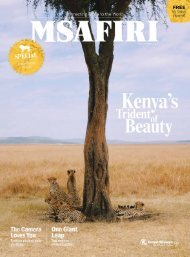You also want an ePaper? Increase the reach of your titles
YUMPU automatically turns print PDFs into web optimized ePapers that Google loves.
64 / WILDLIFE / Conservation<br />
WILDLIFE / 65<br />
Philip Lee Harvey<br />
leaves and fruit. Females become sexually<br />
mature from 11 to 13 years of age. And<br />
despite the fact that elephant families<br />
live apart from the males for so long,<br />
they all know each other as individuals.<br />
“Elephants communicate using infrasonic<br />
vocalisations that can carry over<br />
10 km and in this way distant herds can<br />
stay in touch with each other. This<br />
means they can coordinate their movements<br />
away from trouble and<br />
towards good feeding areas.”<br />
Every year, the female groups and<br />
mature males congregate in a gathering<br />
that’s similar to a Maasai celebration<br />
when warriors return to meet their families:<br />
the elephants greet each other in<br />
noisy celebration.<br />
VITAL FOR OUR ENVIRONMENT<br />
Dr Kahumbu explains that elephants<br />
are some of the most important animals<br />
in African ecology. “They move tremendous<br />
amounts of nutrients around and<br />
shed seeds, which germinate in their<br />
pie-sized dung. This makes them ecosystem<br />
engineers vital for the ecological<br />
health of our savannahs and woodlands.”<br />
Sadly, elephant populations have<br />
dwindled over the decades as a result of<br />
human activities that threatened their<br />
existence. This problem is compounded<br />
by elephants’ long gestation period.<br />
“They have longer pregnancies than<br />
almost any other mammal,” says Dr<br />
Kahumbu. They carry their calves for<br />
about 22 months, with cows usually bearing<br />
only one calf every 3 to 6 years; and<br />
their regeneration rate averages 5 to 6<br />
percent annually, compared to the 8 to 9<br />
percent poaching rates, resulting in a net<br />
loss in population numbers. Elephants<br />
are threatened with extinction as they’re<br />
unable to sustain current population<br />
numbers if the high rate of poaching<br />
continues unabated.”<br />
The African elephant population<br />
reduced dramatically during a ><br />
Hands off<br />
In addition to the strategic Hands Off<br />
Our Elephants partnership between<br />
WildlifeDirect and the country’s First<br />
Lady, Kenya is enjoying growing<br />
corporate support for various elephant<br />
conservation campaigns.<br />
The Sheldrick Wildlife Trust, established<br />
more than 40 years ago, is best<br />
known for its Orphans’ Project: a<br />
pioneering elephant orphan rescue and<br />
rehabilitation programme. Through this<br />
project, the Trust raises orphaned, milkdependent<br />
elephants and reintegrates<br />
them back into the wild.<br />
Through its elephant conservation<br />
programme, the World Wide Fund for<br />
Nature Kenya has helped to develop<br />
the National Elephant Conservation and<br />
Management Strategy 2012-2021 to<br />
address the threats facing elephants.<br />
Ultimately, the programme seeks to<br />
ensure that, in 25 years, elephants and<br />
people live and thrive side by side in the<br />
Serengeti–Masaai Mara area.<br />
“Kenya’s elephant numbers<br />
plummeted from 168,000 to 18,000<br />
between the 1960s and 1980s”<br />
“ONE OF the greatest challenges<br />
facing elephants is no longer poaching<br />
for ivory, but the killing of elephants due<br />
to human-elephant conflict,” says Dr<br />
Paula Kahumbu, one of Africa’s pre-eminent<br />
conservationists. “This is caused by<br />
people encroaching onto elephant ranges,<br />
and elephants moving out of parks and<br />
into farms. To protect elephants, we must<br />
focus on supporting the people who live<br />
in the same landscapes with them.”<br />
On 12 <strong>August</strong>, everyone on Earth<br />
will have the opportunity to make a difference<br />
thanks to the awareness drive<br />
that is World Elephant Day. All you have<br />
to do is experience elephants in nonexploitive<br />
and sustainable environments<br />
where they can thrive under care and<br />
protection.<br />
BET YOU DIDN’T KNOW<br />
According to Dr Kahumbu, elephants<br />
are exceptionally gifted animals<br />
that enjoy a fairly long lifespan, coexist<br />
in tightknit social units and exhibit a<br />
level of compassion that humanity can<br />
learn from. “Elephants live until about<br />
75 years old,” says Dr Kahumbu. “They<br />
have enormous brains and are extremely<br />
intelligent. They know how to navigate<br />
vast landscapes and how to stay safe.<br />
They’re also compassionate and will<br />
support each other through childbirth<br />
and injuries, and they will stay and<br />
mourn the dead returning to the skeletons<br />
of their relatives. How they can<br />
know the identity of the skeleton is a<br />
mystery to us.”<br />
Elephants are the world’s largest land<br />
animals, with male African elephants<br />
attaining a height of 3 m and weighing<br />
4,000-7,500 kg. Asian elephants are<br />
slightly smaller, reaching a height of 2.7<br />
m and weighing 3,000-6,000 kg. There<br />
are two types of elephants found in Africa:<br />
the savannah elephant – found across<br />
East and Southern Africa – and the forest<br />
elephant, which is only found in the<br />
Congo Basin. Forest elephants look<br />
similar to savannah elephants but are<br />
smaller, have straighter tusks and live in<br />
smaller groups.<br />
Like humans, elephants live in families<br />
but, uniquely, the females lead these<br />
families. Males leave their families at the<br />
age of 14 to join bachelor groups, which<br />
move away from the breeding herds and<br />
into wooded areas where they feed and<br />
grow. They return to the family territories<br />
when they’re in their 30s and in<br />
breeding condition. Of particular note is<br />
the leadership model among elephants.<br />
“Leadership in elephants is gentle and<br />
yet assertive,” says Dr Kahumbu. “The<br />
matriarch always keeps her family out<br />
of harm’s way and will fight to protect<br />
every individual in the family. We need<br />
wise, compassionate leaders too.”<br />
Elephants occupy every habitat<br />
except marine environments and tops<br />
of icy mountains, and they can feed on<br />
everything from grass to a tree’s bark,<br />
David Yarrow<br />
Philip Lee Harvey
















